Current and Future Land Use Characters of a National Central City in Eco-Fragile Region—A Case Study in Xi’an City Based on FLUS Model
Abstract
:1. Introduction
2. Materials and Methods
2.1. Study Area
2.2. Data Source and Processing
2.3. Methodology
2.4. Methods
2.4.1. Markov-FLUS Model
2.4.2. Land Use Simulation Setting and Simulation Accuracy
2.4.3. Complex Network Model
2.4.4. Characteristics of the land use
3. Results
3.1. Accuracy Evaluation of the Simulations
3.2. General Land Use Change and Simulation
3.3. Analysis of the Characteristics of Land Use Change
3.3.1. Land Use Characteristics
3.3.2. Land Pattern Characteristics
3.4. Characteristics of the Land Use Change Network
4. Discussion
4.1. Urban Development and Ecological Environment
4.2. “Grain for Green” Program
4.3. Cropland Protection and Efficient Utilization
5. Policies Implication
5.1. Continuously Implemented Afforestation
5.2. Scientific Control of Rapid Urban Expansion and Cropland Protection
5.3. Effective Redevelopment of Un-Utilized Land
6. Conclusions
Author Contributions
Funding
Data Availability Statement
Conflicts of Interest
References
- Sterling, S.M.; Ducharne, A.; Polcher, J. The impact of global land-cover change on the terrestrial water cycle. Nat. Clim. Chang. 2012, 3, 385–390. [Google Scholar] [CrossRef]
- Tian, H.; Lu, C.; Ciais, P.; Michalak, A.M.; Canadell, J.G.; Saikawa, E.; Huntzinger, D.N.; Gurney, K.R.; Sitch, S.; Zhang, B.; et al. The terrestrial biosphere as a net source of greenhouse gases to the atmosphere. Nat. Cell Biol. 2016, 531, 225–228. [Google Scholar] [CrossRef] [PubMed] [Green Version]
- Song, X.-P.; Hansen, M.C.; Stehman, S.V.; Potapov, P.V.; Tyukavina, A.; Vermote, E.F.; Townshend, J.R. Global land change from 1982 to 2016. Nat. Cell Biol. 2018, 560, 639–643. [Google Scholar] [CrossRef] [PubMed]
- Poeplau, C.; Don, A.; Vesterdal, L.; Leifeld, J.; Van Wesemael, B.; Schumacher, J.; Gensior, A. Temporal dynamics of soil organic carbon after land-use change in the temperate zone—Carbon response functions as a model approach. Glob. Chang. Biol. 2011, 17, 2415–2427. [Google Scholar] [CrossRef]
- Seto, K.C.; Güneralp, B.; Hutyra, L.R. Global forecasts of urban expansion to 2030 and direct impacts on biodiversity and carbon pools. Proc. Natl. Acad. Sci. USA 2012, 109, 16083–16088. [Google Scholar] [CrossRef] [PubMed] [Green Version]
- Verburg, P.H.; Neumann, K.; Nol, L. Challenges in using land use and land cover data for global change studies. Glob. Chang. Biol. 2011, 17, 974–989. [Google Scholar] [CrossRef] [Green Version]
- Arias-Ortiz, A.; Serrano, O.; Masqué, P.; Lavery, P.S.; Mueller, U.; Kendrick, G.A.; Rozaimi, M.; Esteban, A.; Fourqurean, J.W.; Marbà, N.; et al. A marine heatwave drives massive losses from the world’s largest seagrass carbon stocks. Nat. Clim. Chang. 2018, 8, 338–344. [Google Scholar] [CrossRef] [Green Version]
- Wu, D.H.; Zhao, X.; Liang, S.L.; Zhou, T.; Huang, K.C.; Tang, B.J.; Zhao, W.Q. Time-lag effects of global vegetation responses to climate change. Glob. Chang. Biol. 2015, 21, 3520–3531. [Google Scholar] [CrossRef] [PubMed]
- Friend, A.D.; Lucht, W.; Rademacher, T.T.; Keribin, R.; Betts, R.; Cadule, P.; Ciais, P.; Clark, D.B.; Dankers, R.; Falloon, P.D.; et al. Carbon residence time dominates uncertainty in terrestrial vegetation responses to future climate and atmospheric CO2. Proc. Natl. Acad. Sci. USA 2014, 111, 3280–3285. [Google Scholar] [CrossRef] [Green Version]
- Yin, H.; Pflugmacher, D.; Li, A.; Li, Z.; Hostert, P. Land use and land cover change in Inner Mongolia—Understanding the effects of China’s re-vegetation programs. Remote Sens. Environ. 2018, 204, 918–930. [Google Scholar] [CrossRef]
- Christensen, P.; Mccord, G.C. Geographic determinants of China’s urbanization. Reg. Sci. Urban Econ. 2016, 59, 90–102. [Google Scholar] [CrossRef] [Green Version]
- Tong, X.; Wang, K.; Brandt, M.; Yue, Y.; Liao, C.; Fensholt, R. Assessing Future Vegetation Trends and Restoration Prospects in the Karst Regions of Southwest China. Remote Sens. 2016, 8, 357. [Google Scholar] [CrossRef] [Green Version]
- Ziadat, F.M.; Taimeh, A.Y. Effect of rainfall intensity, slope, land use and antecedent soil moisture on soil erosion in an arid environment. Land Degrad. Dev. 2013, 24, 582–590. [Google Scholar] [CrossRef]
- El Kateb, H.; Zhang, H.; Zhang, P.; Mosandl, R. Soil erosion and surface runoff on different vegetation covers and slope gradients: A field experiment in Southern Shaanxi Province, China. Catena 2013, 105, 1–10. [Google Scholar] [CrossRef]
- Shen, H.; Zheng, F.; Wen, L.; Han, Y.; Hu, W. Impacts of rainfall intensity and slope gradient on rill erosion processes at loessial hillslope. Soil Tillage Res. 2016, 155, 429–436. [Google Scholar] [CrossRef]
- Wei, Y.D.; Li, H.; Yue, W. Urban land expansion and regional inequality in transitional China. Landsc. Urban Plan. 2017, 163, 17–31. [Google Scholar] [CrossRef]
- Zheng, K.; Wei, J.-Z.; Pei, J.-Y.; Cheng, H.; Zhang, X.-L.; Huang, F.-Q.; Li, F.-M.; Ye, J.-S. Impacts of climate change and human activities on grassland vegetation variation in the Chinese Loess Plateau. Sci. Total. Environ. 2019, 660, 236–244. [Google Scholar] [CrossRef]
- Alexander, P.; Rounsevell, M.D.; Dislich, C.; Dodson, J.R.; Engström, K.; Moran, D. Drivers for global agricultural land use change: The nexus of diet, population, yield and bioenergy. Glob. Environ. Chang. 2015, 35, 138–147. [Google Scholar] [CrossRef] [Green Version]
- Dadashpoor, H.; Azizi, P.; Moghadasi, M. Land use change, urbanization, and change in landscape pattern in a metropolitan area. Sci. Total. Environ. 2019, 655, 707–719. [Google Scholar] [CrossRef] [PubMed]
- Tong, D.; Wang, X.; Wu, L.; Zhao, N. Land ownership and the likelihood of land development at the urban fringe: The case of Shenzhen, China. Habitat Int. 2018, 73, 43–52. [Google Scholar] [CrossRef]
- Wu, Y.; Luo, J.; Zhang, X.; Skitmore, M. Urban growth dilemmas and solutions in China: Looking forward to 2030. Habitat Int. 2016, 56, 42–51. [Google Scholar] [CrossRef] [Green Version]
- Freitas, S.R.; Hawbaker, T.J.; Metzger, J.P. Effects of roads, topography, and land use on forest cover dynamics in the Brazilian Atlantic Forest. For. Ecol. Manag. 2010, 259, 410–417. [Google Scholar] [CrossRef]
- Song, W. Decoupling cultivated land loss by construction occupation from economic growth in Beijing. Habitat Int. 2014, 43, 198–205. [Google Scholar] [CrossRef]
- Toth, C.; Jóźków, G. Remote sensing platforms and sensors: A survey. ISPRS J. Photogramm. Remote. Sens. 2016, 115, 22–36. [Google Scholar] [CrossRef]
- Atzberger, C. Advances in Remote Sensing of Agriculture: Context Description, Existing Operational Monitoring Systems and Major Information Needs. Remote Sens. 2013, 5, 949–981. [Google Scholar] [CrossRef] [Green Version]
- Hussain, M.; Chen, D.; Cheng, A.; Wei, H.; Stanley, D. Change detection from remotely sensed images: From pixel-based to object-based approaches. ISPRS J. Photogramm. Remote Sens. 2013, 80, 91–106. [Google Scholar] [CrossRef]
- Dewan, A.M.; Yamaguchi, Y. Land use and land cover change in Greater Dhaka, Bangladesh: Using remote sensing to promote sustainable urbanization. Appl. Geogr. 2009, 29, 390–401. [Google Scholar] [CrossRef]
- Ning, J.; Liu, J.; Kuang, W.; Xu, X.; Zhang, S.; Yan, C.; Li, R.; Wu, S.; Hu, Y.; Du, G.; et al. Spatiotemporal patterns and characteristics of land-use change in China during 2010–2015. J. Geogr. Sci. 2018, 28, 547–562. [Google Scholar] [CrossRef] [Green Version]
- Mustafa, A.; Heppenstall, A.; Omrani, H.; Saadi, I.; Cools, M.; Teller, J. Modelling built-up expansion and densification with multinomial logistic regression, cellular automata and genetic algorithm. Comput. Environ. Urban Syst. 2018, 67, 147–156. [Google Scholar] [CrossRef] [Green Version]
- Shen, Q.; Chen, Q.; Tang, B.-S.; Yeung, S.; Hu, Y.; Cheung, G. A system dynamics model for the sustainable land use planning and development. Habitat Int. 2009, 33, 15–25. [Google Scholar] [CrossRef]
- Lin, J.; Gau, C. A TOD planning model to review the regulation of allowable development densities around subway stations. Land Use Policy 2006, 23, 353–360. [Google Scholar] [CrossRef]
- Halmy, M.W.A.; Gessler, P.E.; Hicke, J.A.; Salem, B.B. Land use/land cover change detection and prediction in the north-western coastal desert of Egypt using Markov-CA. Appl. Geogr. 2015, 63, 101–112. [Google Scholar] [CrossRef]
- Yang, X.; Zheng, X.-Q.; Lv, L.-N. A spatiotemporal model of land use change based on ant colony optimization, Markov chain and cellular automata. Ecol. Model. 2012, 233, 11–19. [Google Scholar] [CrossRef]
- Liu, X.; Liang, X.; Li, X.; Xu, X.; Ou, J.; Chen, Y.; Li, S.; Wang, S.; Pei, F. A future land use simulation model (FLUS) for simulating multiple land use scenarios by coupling human and natural effects. Landsc. Urban Plan. 2017, 168, 94–116. [Google Scholar] [CrossRef]
- Zheng, F.; Hu, Y. Assessing temporal-spatial land use simulation effects with CLUE-S and Markov-CA models in Beijing. Environ. Sci. Pollut. Res. 2018, 25, 32231–32245. [Google Scholar] [CrossRef] [PubMed]
- Zhou, R.; Zhang, H.; Ye, X.-Y.; Wang, X.-J.; Su, H.-L. The Delimitation of Urban Growth Boundaries Using the CLUE-S Land-Use Change Model: Study on Xinzhuang Town, Changshu City, China. Sustainability 2016, 8, 1182. [Google Scholar] [CrossRef] [Green Version]
- Zhang, D.; Liu, X.; Lin, Z.; Zhang, X.; Zhang, H. The delineation of urban growth boundaries in complex ecological environment areas by using cellular automata and a dual-environmental evaluation. J. Clean. Prod. 2020, 256, 120361. [Google Scholar] [CrossRef]
- Fox, J.; Vogler, J.B.; Sen, O.L.; Giambelluca, T.W.; Ziegler, A.D. Simulating Land-Cover Change in Montane Mainland Southeast Asia. Environ. Manag. 2012, 49, 968–979. [Google Scholar] [CrossRef] [PubMed]
- Xia, T.; Wu, W.; Zhou, Q.; Verburg, P.H.; Yu, Q.; Yang, P.; Ye, L. Model-based analysis of spatio-temporal changes in land use in Northeast China. J. Geogr. Sci. 2015, 26, 171–187. [Google Scholar] [CrossRef]
- Zheng, X.-Q.; Zhao, L.; Xiang, W.-N.; Li, N.; Lv, L.-N.; Yang, X. A coupled model for simulating spatio-temporal dynamics of land-use change: A case study in Changqing, Jinan, China. Landsc. Urban Plan. 2012, 106, 51–61. [Google Scholar] [CrossRef]
- Du, X.; Zhao, X.; Liang, S.; Zhao, J.; Xu, P.; Wu, D. Quantitatively Assessing and Attributing Land Use and Land Cover Changes on China’s Loess Plateau. Remote. Sens. 2020, 12, 353. [Google Scholar] [CrossRef] [Green Version]
- Sun, R.; Ye, J.; Tang, K.; Zhang, K.; Zhang, X.; Ren, Y. Big Data Aided Vehicular Network Feature Analysis and Mobility Models Design. Mob. Netw. Appl. 2018, 23, 1487–1495. [Google Scholar] [CrossRef]
- Morone, F.; Makse, H.A. Influence maximization in complex networks through optimal percolation. Nat. Cell Biol. 2015, 524, 65–68. [Google Scholar] [CrossRef] [Green Version]
- Wang, S.; Cheng, W.; Mei, G. Efficient Method for Improving the Spreading Efficiency in Small-World Networks and Assortative Scale-Free Networks. IEEE Access 2019, 7, 46122–46134. [Google Scholar] [CrossRef]
- Wang, L.; Song, R.; Qu, Z.; Zhao, H.; Zhai, C. Study of China’s Publicity Translations Based on Complex Network Theory. IEEE Access 2018, 6, 35753–35763. [Google Scholar] [CrossRef]
- Jia, X.; Shao, M.; Zhu, Y.; Luo, Y. Soil moisture decline due to afforestation across the Loess Plateau, China. J. Hydrol. 2017, 546, 113–122. [Google Scholar] [CrossRef]
- Moghadam, H.S.; Helbich, M. Spatiotemporal urbanization processes in the megacity of Mumbai, India: A Markov chains-cellular automata urban growth model. Appl. Geogr. 2013, 40, 140–149. [Google Scholar] [CrossRef]
- Van Vliet, J.; Hagen-Zanker, A.; Hurkens, J.; Van Delden, H. A fuzzy set approach to assess the predictive accuracy of land use simulations. Ecol. Model. 2013, 261–262, 32–42. [Google Scholar] [CrossRef]
- Van Vliet, J.; Bregt, A.K.; Hagen-Zanker, A. Revisiting Kappa to account for change in the accuracy assessment of land-use change models. Ecol. Model. 2011, 222, 1367–1375. [Google Scholar] [CrossRef]
- Zhang, M.; Wang, J.; Feng, Y. Temporal and spatial change of land use in a large-scale opencast coal mine area: A complex network approach. Land Use Policy 2019, 86, 375–386. [Google Scholar] [CrossRef]
- Zhang, Z.; Wang, J.; Li, B. Determining the influence factors of soil organic carbon stock in opencast coal-mine dumps based on complex network theory. Catena 2019, 173, 433–444. [Google Scholar] [CrossRef]
- Wang, Y.; Li, X.; Li, J.; Huang, Z.; Xiao, R. Impact of Rapid Urbanization on Vulnerability of Land System from Complex Networks View: A Methodological Approach. Complexity 2018, 2018, 1–18. [Google Scholar] [CrossRef] [Green Version]
- Yang, Y.; Liu, Y.; Li, Y.; Du, G. Quantifying spatio-temporal patterns of urban expansion in Beijing during 1985–2013 with rural-urban development transformation. Land Use Policy 2018, 74, 220–230. [Google Scholar] [CrossRef]
- Wang, H.; Zhu, P.; Chen, X.; Swider, S. Land expropriation in urbanizing China: An examination of negotiations and compensation. Urban Geogr. 2017, 38, 401–419. [Google Scholar] [CrossRef] [Green Version]
- Yang, Y.; Bao, W.; Liu, Y. Scenario simulation of land system change in the Beijing-Tianjin-Hebei region. Land Use Policy 2020, 96, 104677. [Google Scholar] [CrossRef]
- Chen, M.; Liu, W.; Lu, D. Challenges and the way forward in China’s new-type urbanization. Land Use Policy 2016, 55, 334–339. [Google Scholar] [CrossRef]
- Du, Y.; Wan, Q.; Liu, H.; Liu, H.; Kapsar, K.; Peng, J. How does urbanization influence PM2.5 concentrations? Perspective of spillover effect of multi-dimensional urbanization impact. J. Clean. Prod. 2019, 220, 974–983. [Google Scholar] [CrossRef]
- Li, J.; Peng, S.; Li, Z. Detecting and attributing vegetation changes on China’s Loess Plateau. Agric. For. Meteorol. 2017, 247, 260–270. [Google Scholar] [CrossRef]
- Liu, Z.; Wang, J.; Wang, X.; Wang, Y. Understanding the impacts of ‘Grain for Green’ land management practice on land greening dynamics over the Loess Plateau of China. Land Use Policy 2020, 99, 105084. [Google Scholar] [CrossRef]
- Cao, S.; Chen, L.; Shankman, D.; Wang, C.; Wang, X.; Zhang, H. Excessive reliance on afforestation in China’s arid and semi-arid regions: Lessons in ecological restoration. Earth-Sci. Rev. 2011, 104, 240–245. [Google Scholar] [CrossRef]
- Lu, Q.; Xu, B.; Liang, F.; Gao, Z.; Ning, J. Influences of the Grain-for-Green project on grain security in southern China. Ecol. Indic. 2013, 34, 616–622. [Google Scholar] [CrossRef] [Green Version]
- Liu, F.; Zhang, Z.; Zhao, X.; Wang, X.; Zuo, L.; Wen, Q.; Yi, L.; Xu, J.; Hu, S.; Liu, B. Chinese cropland losses due to urban expansion in the past four decades. Sci. Total. Environ. 2019, 650, 847–857. [Google Scholar] [CrossRef] [PubMed]
- Ke, X.; van Vliet, J.; Zhou, T.; Verburg, P.H.; Zheng, W.; Liu, X. Direct and indirect loss of natural habitat due to built-up area expansion: A model-based analysis for the city of Wuhan, China. Land Use Policy 2018, 74, 231–239. [Google Scholar] [CrossRef]
- Zheng, W.; Ke, X.; Zhou, T.; Yang, B. Trade-offs between cropland quality and ecosystem services of marginal compensated cropland—A case study in Wuhan, China. Ecol. Indic. 2019, 105, 613–620. [Google Scholar] [CrossRef]
- Liu, Y.; Feng, Y.; Zhao, Z.; Zhang, Q.; Su, S. Socioeconomic drivers of forest loss and fragmentation: A comparison between different land use planning schemes and policy implications. Land Use Policy 2016, 54, 58–68. [Google Scholar] [CrossRef]


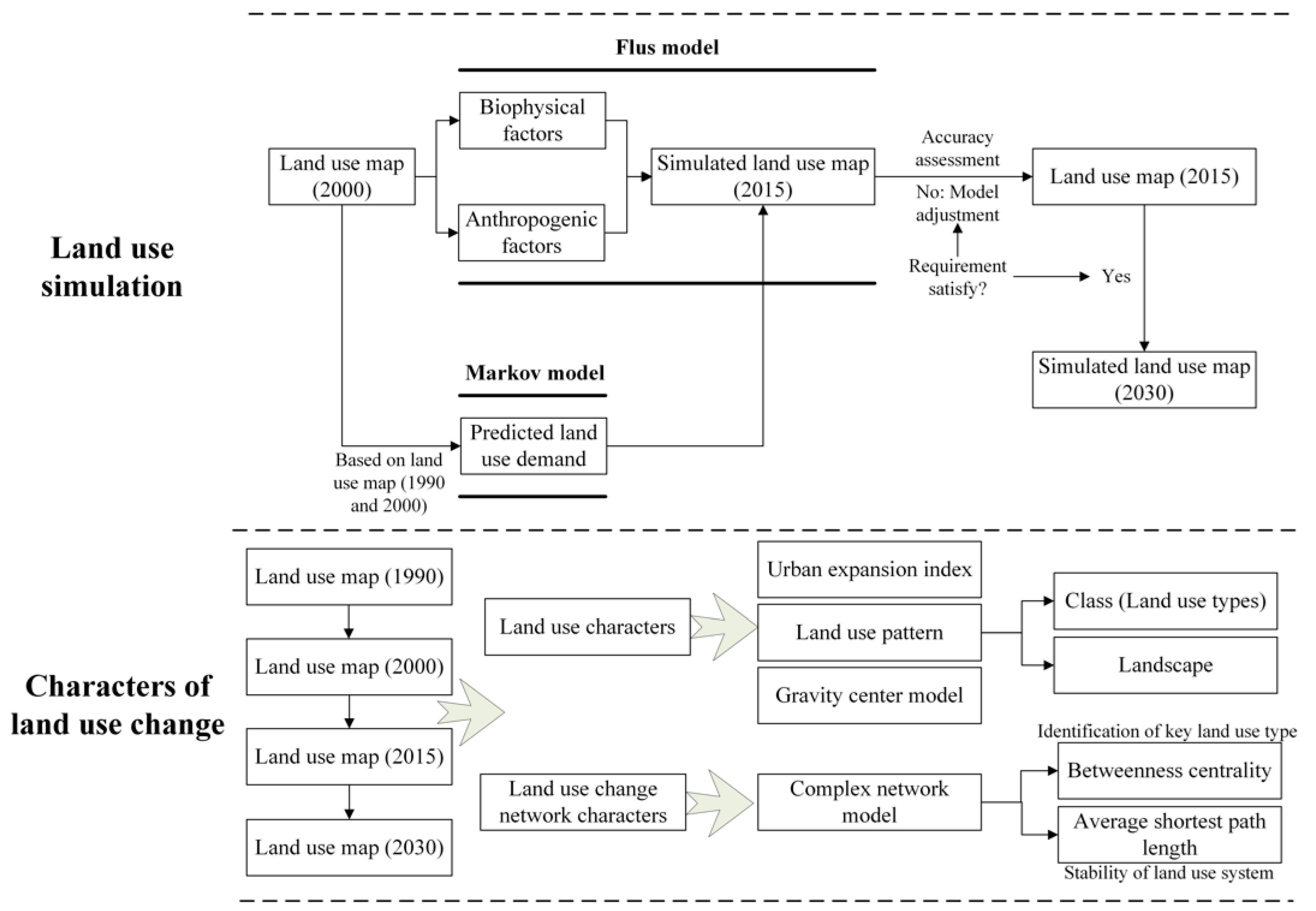



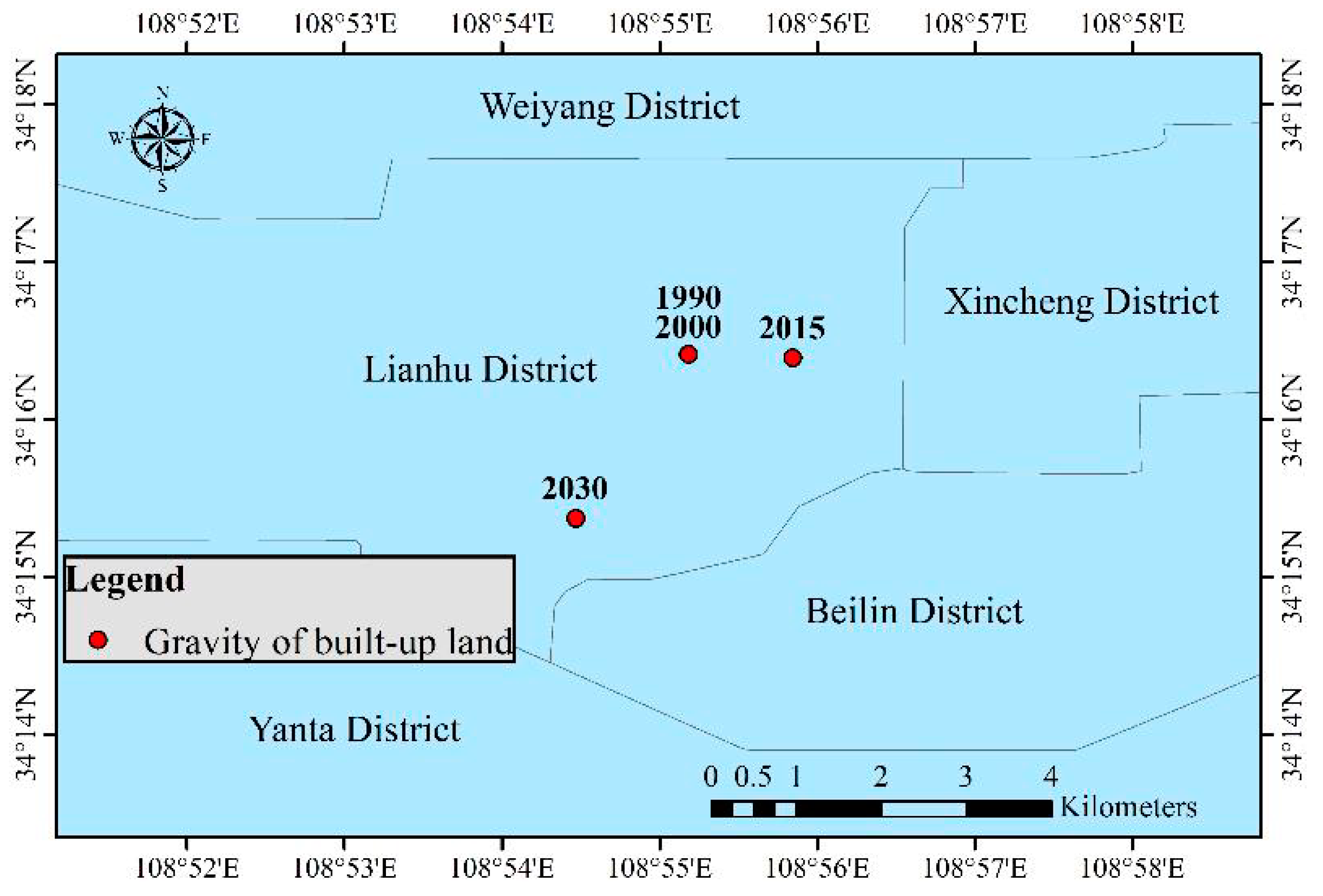
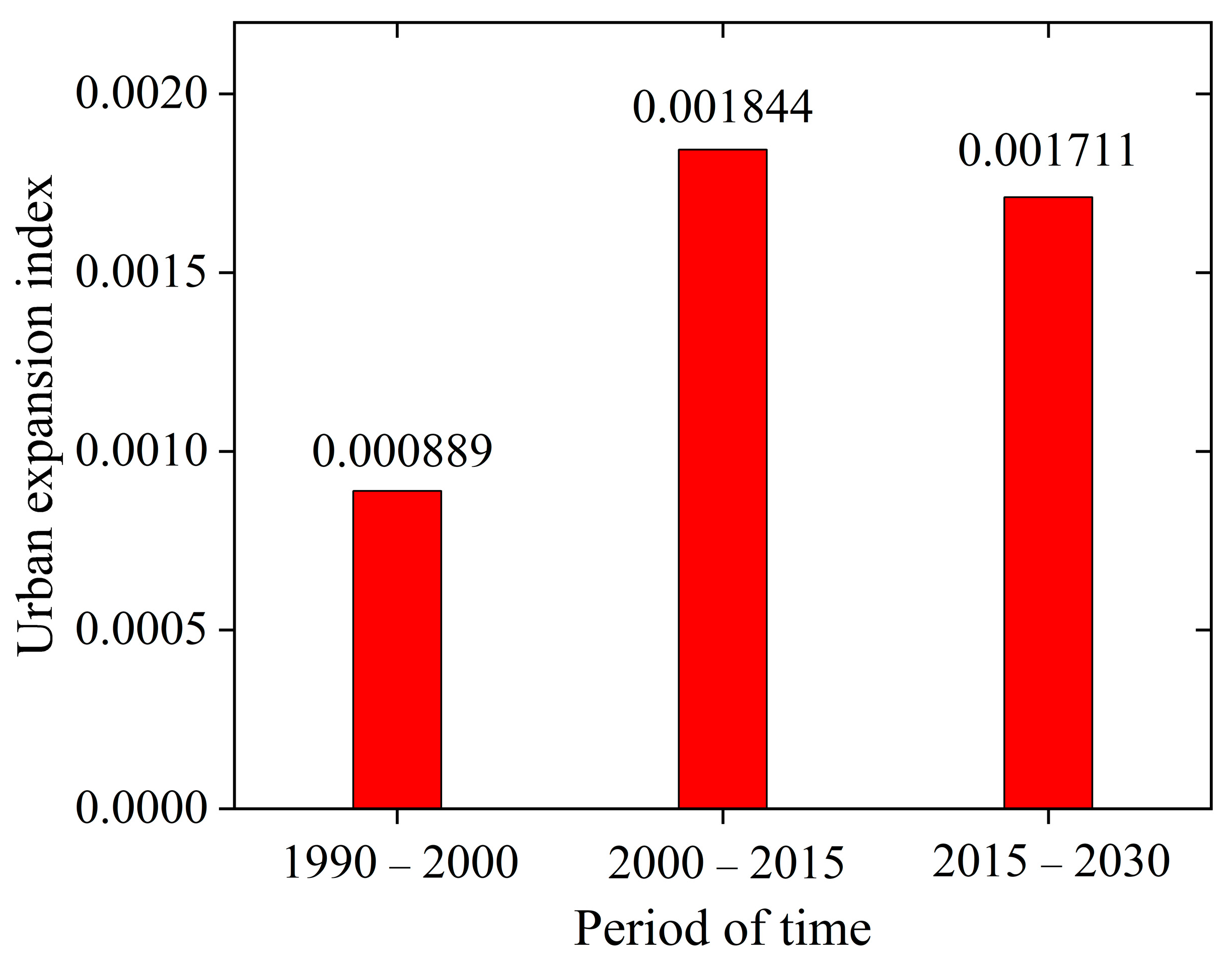

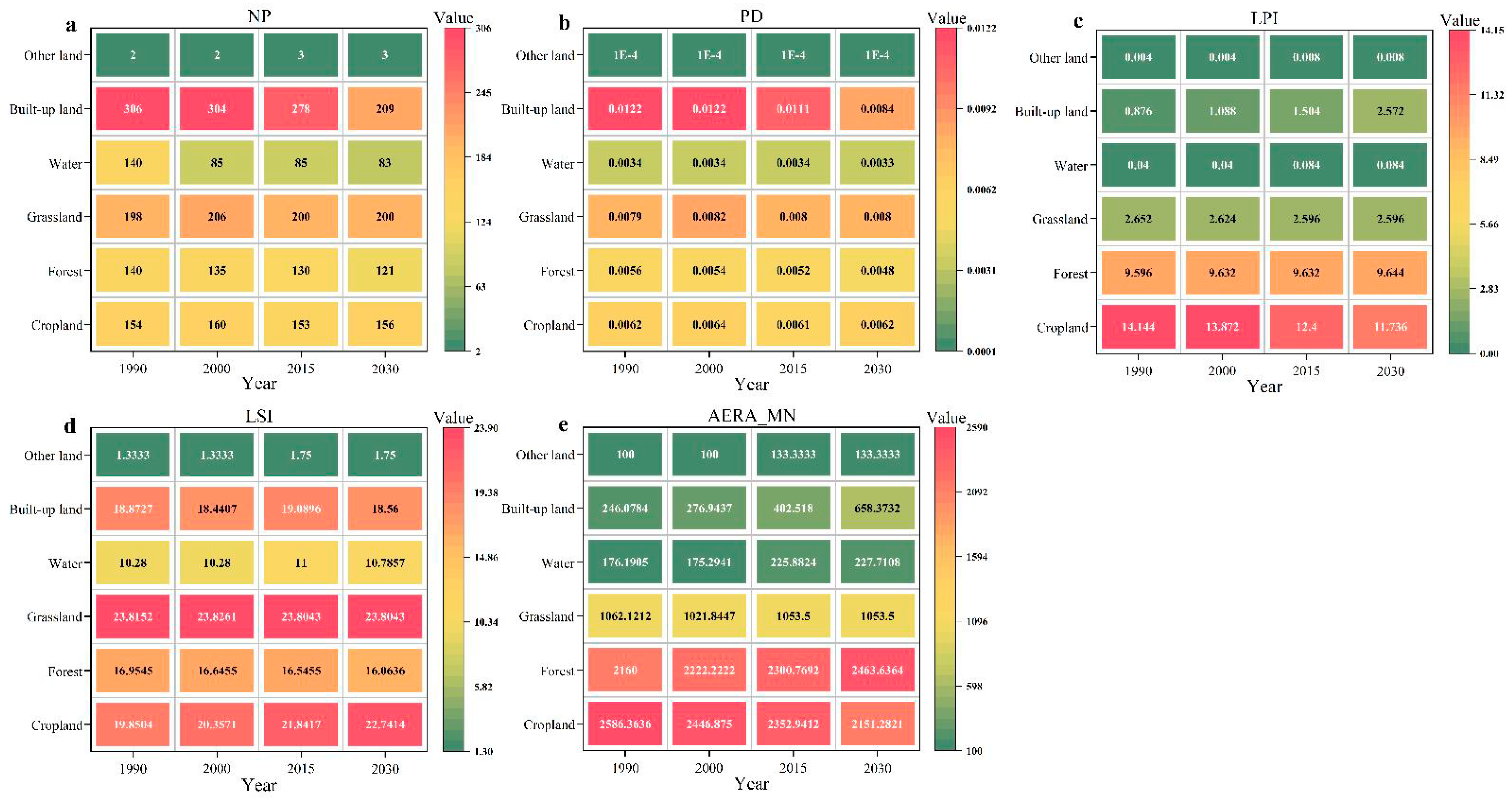


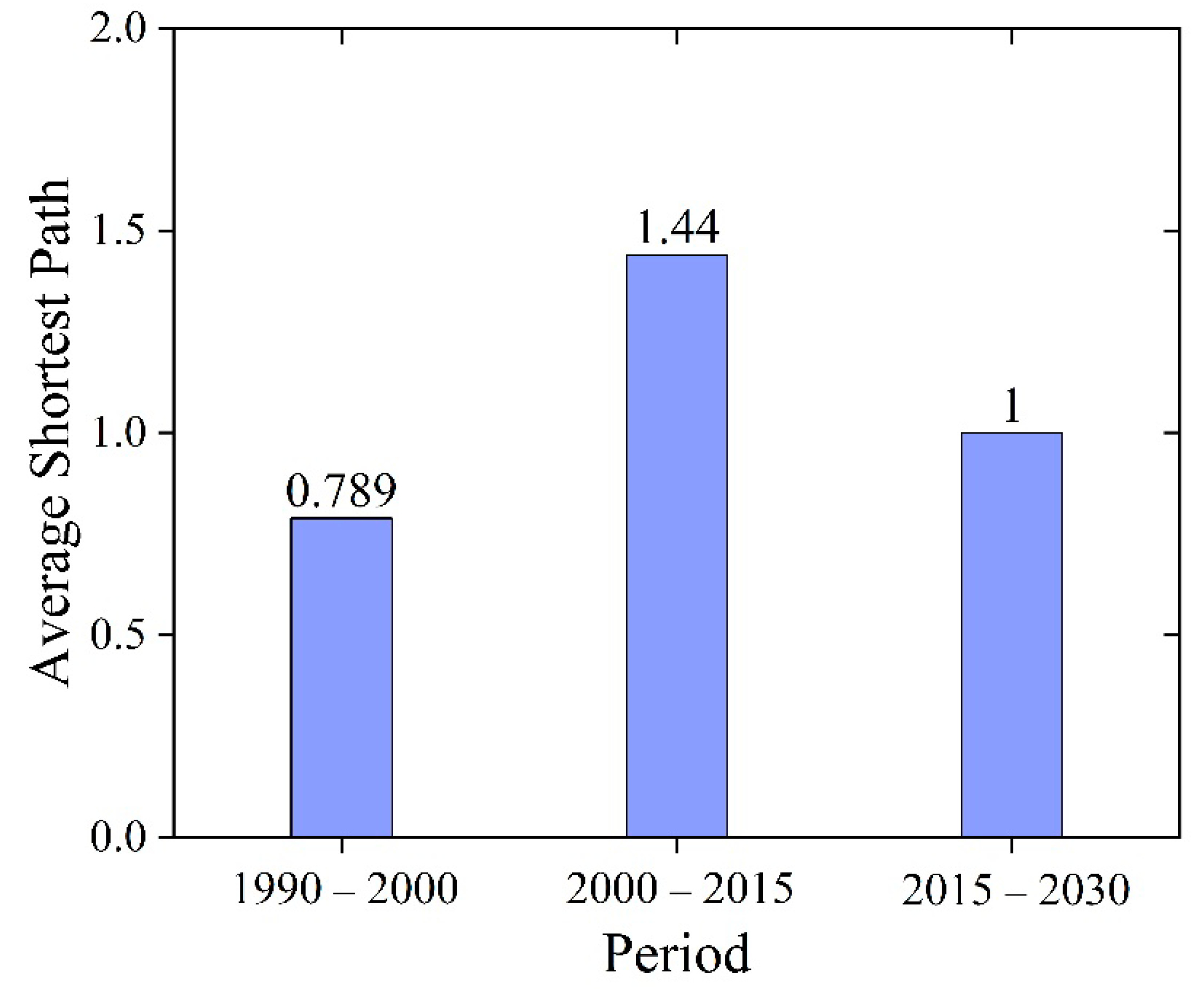
| Datasets | Institution | Website |
|---|---|---|
| DEM | Geospatial Data Cloud site, Computer Network Information Center, Chinese Academy of Sciences | http://www.gscloud.cn |
| Slope | Calculated with the DEM | - |
| Soil texture | Resource and Environment Data Cloud Platform, Institute of Geographic and Natural Resources Research | http://www.resdc.cn/ |
| Temperature | ||
| Precipitation | ||
| Population density | Resource and Environment Data Cloud Platform, Institute of Geographic and Natural Resources Research | http://www.resdc.cn/ |
| Gross domestic product | ||
| Railway | National Catalogue Service for Geographic Information | http://www.webmap.cn/ |
| Road | Global Roads Open Access Data Set (gROADS), Socioeconomic Data and Applications Center | https://sedac.ciesin.columbia.edu/data/set/groads-global-roads-open-access-v1 |
| Rural settlement | National Catalogue Service for Geographic Information | http://www.webmap.cn/ |
| Urban center | Resource and Environment Data Cloud Platform, Institute of Geographic and Natural Resources Research | http://www.resdc.cn/ |
| Category | Indicators | Resolution |
|---|---|---|
| Biophysical factors | Altitude | 90 m |
| Slope | 90 m | |
| Soil | ||
| Temperature | 1000 m | |
| Precipitation | 1000 m | |
| Anthropogenic factors | Population Density | 1000 m |
| Gross domestic product | 1000 m | |
| Distance to railway | Vector | |
| Distance to road | Vector | |
| Distance to rural settlement | Vector | |
| Distance to the urban center | Vector |
| Types | Indicators |
|---|---|
| Class | Number of patches (NP), patch density (PD), largest patch index (LPI), landscape shape index (LSI), mean patch size (AREA_MN) |
| Landscape | Patch density (PD), number of patches (NP), largest patch index (LPI), Shannon’s diversity index (SHDI), mean patch area (AREA_MN), perimeter-area fractal dimension (FRAC_MN), mean patch shape index (SHAPE_MN), interspersion & juxtaposition index (IJI) |
| Types | Indicators | Definitions |
|---|---|---|
| Class | NP | Total number of a certain types. |
| PD | Number of patches in a given class, divided by the class area, multiplied by 10,000 and 100. | |
| LPI | Area of the largest patch of the corresponding patch type divided by the total landscape area, multiplied by 100. | |
| LSI | A quarter of the sum of the entire landscape boundary and all edge segments within the landscape boundary involving the corresponding patch type. | |
| AREA_MN | Mean value, across all patches of the corresponding patch types, of the corresponding patch metrics, divided by the number of patches of the same type. | |
| Landscape | PD | Number of patches in the landscape, divided by the total landscape area, multiplied by 10,000 and 100. |
| NP | Number of patches in the total landscape. | |
| LPI | Area of the largest patch of the corresponding patch type divided by the total landscape area. | |
| SHDI | Negative value of the sum, across all patch types, of the proportional abundance of each patch type multiplied by the proportion. | |
| AREA_MN | Mean value, across all patches of the corresponding patch types, of the corresponding patch metrics in the landscape. | |
| FRAC_MN | Two divided by the slope of the regression line obtained by regressing the logarithm of the patch area against the logarithm of the patch perimeter. | |
| SHAPE_MN | Mean value of the patch perimeter divided by the square root of the patch area, adjusted by a constant to adjust for a square standard. | |
| IJI | Negative value of the sum of the length of each unique edge type divided by the total landscape edge, multiplied by the logarithm of the same quantity, summed over each unique edge type. |
| Land Use Type | Producer Accuracy | User Accuracy | Kappa Coefficient |
|---|---|---|---|
| Cropland | 0.932584 | 0.932584 | 0.922535 |
| Forest | 0.980456 | 0.98366 | |
| Grassland | 0.981221 | 0.972093 | |
| Water | 0.764706 | 0.928571 | |
| Built-up land | 0.831776 | 0.816514 | |
| Other land | 1 | 1 |
| Land Use Type | Weighted Indegree | Weighted Outdegree | Weighted Indegree/Weighted Outdegree |
|---|---|---|---|
| Cropland | 3915 | 3983 | 0.983 |
| Forest | 3000 | 3024 | 0.992 |
| Grassland | 2105 | 2103 | 0.999 |
| Water | 149 | 148 | 1.001 |
| Built-up land | 842 | 753 | 1.118 |
| Other land | 2 | 2 | 1.000 |
| Land Use Type | Weighted Indegree | Weighted Outdegree | Weighted Indegree/Weighted Outdegree |
|---|---|---|---|
| Cropland | 3600 | 3915 | 0.920 |
| Forest | 2991 | 3000 | 0.997 |
| Grassland | 2107 | 2105 | 1.001 |
| Water | 192 | 149 | 1.289 |
| Built-up land | 1119 | 842 | 1.329 |
| Other land | 4 | 2 | 2.000 |
| Land Use Type | Weighted Indegree | Weighted Outdegree | Weighted Indegree/Weighted Outdegree |
|---|---|---|---|
| Cropland | 3356 | 3600 | 0.932 |
| Forest | 2981 | 2991 | 0.997 |
| Grassland | 2107 | 2107 | 1.000 |
| Water | 189 | 192 | 0.984 |
| Built-up land | 1376 | 1119 | 1.230 |
| Other land | 4 | 4 | 1.000 |
| Land Use Type | Betweenness Centrality |
|---|---|
| Cropland | 8.0 |
| Forest | 0.0 |
| Grassland | 0.0 |
| Water | 0.0 |
| Built-up land | 0.0 |
| Other land | 0.0 |
| Land Use Type | Betweenness Centrality |
|---|---|
| Cropland | 7.0 |
| Forest | 1.5 |
| Grassland | 1.83 |
| Water | 0.33 |
| Built-up land | 0.33 |
| Other land | 0.0 |
| Land Use Type | Betweenness Centrality |
|---|---|
| Cropland | 0.0 |
| Forest | 0.0 |
| Grassland | 0.0 |
| Water | 0.0 |
| Built-up land | 0.0 |
| Other land | 0.0 |
Publisher’s Note: MDPI stays neutral with regard to jurisdictional claims in published maps and institutional affiliations. |
© 2021 by the authors. Licensee MDPI, Basel, Switzerland. This article is an open access article distributed under the terms and conditions of the Creative Commons Attribution (CC BY) license (http://creativecommons.org/licenses/by/4.0/).
Share and Cite
Feng, D.; Bao, W.; Fu, M.; Zhang, M.; Sun, Y. Current and Future Land Use Characters of a National Central City in Eco-Fragile Region—A Case Study in Xi’an City Based on FLUS Model. Land 2021, 10, 286. https://doi.org/10.3390/land10030286
Feng D, Bao W, Fu M, Zhang M, Sun Y. Current and Future Land Use Characters of a National Central City in Eco-Fragile Region—A Case Study in Xi’an City Based on FLUS Model. Land. 2021; 10(3):286. https://doi.org/10.3390/land10030286
Chicago/Turabian StyleFeng, Dingrao, Wenkai Bao, Meichen Fu, Min Zhang, and Yiyu Sun. 2021. "Current and Future Land Use Characters of a National Central City in Eco-Fragile Region—A Case Study in Xi’an City Based on FLUS Model" Land 10, no. 3: 286. https://doi.org/10.3390/land10030286
APA StyleFeng, D., Bao, W., Fu, M., Zhang, M., & Sun, Y. (2021). Current and Future Land Use Characters of a National Central City in Eco-Fragile Region—A Case Study in Xi’an City Based on FLUS Model. Land, 10(3), 286. https://doi.org/10.3390/land10030286





